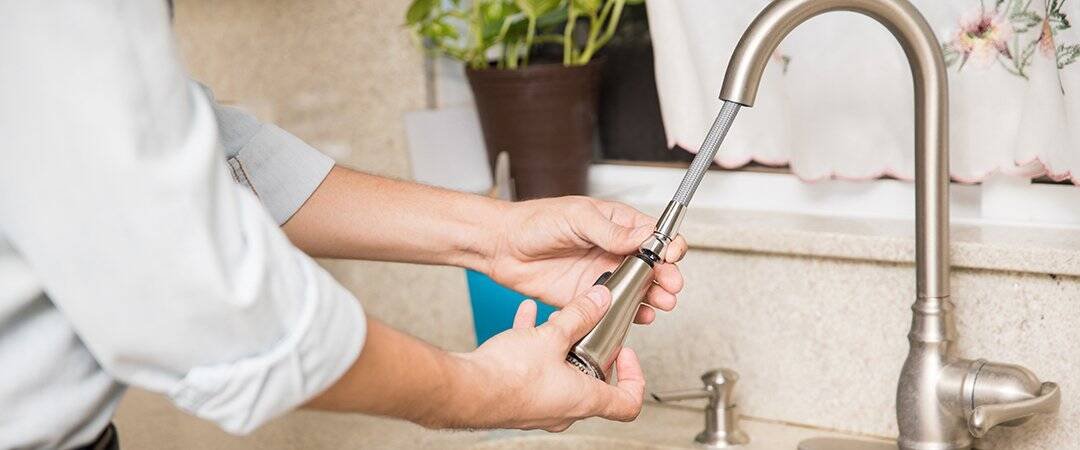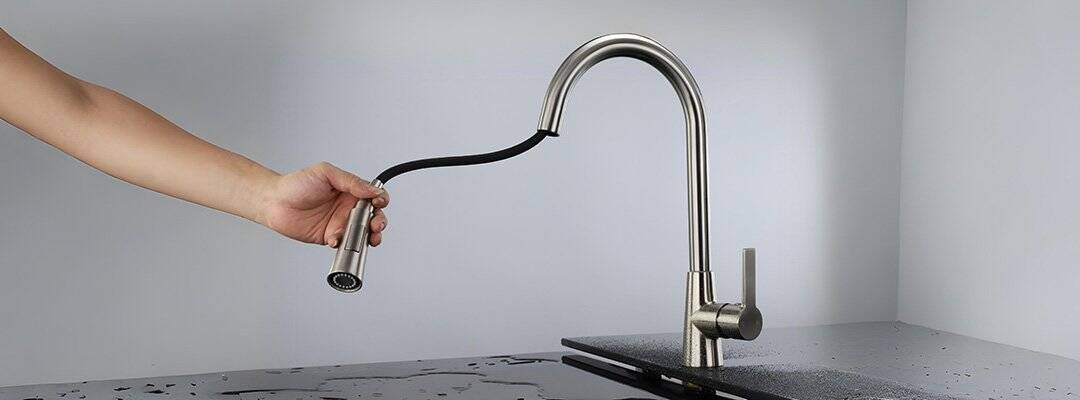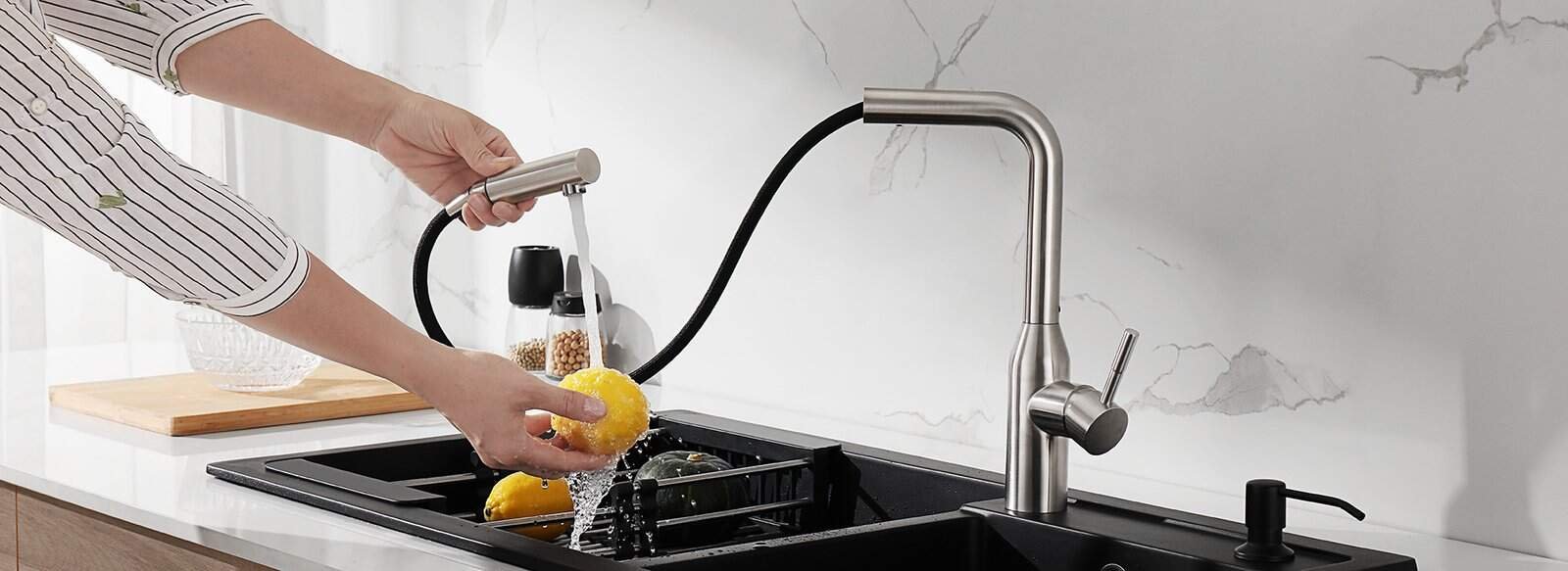That pull-out kitchen faucet was meant to be a game-changer—sleek, convenient, perfect for rinsing and cleaning. Now the spray head just hangs, refusing to retract, turning convenience into daily frustration.
The good news? If your Pull-Out Faucet Hose Won’t Retract, you don’t need a plumber. You can fix this yourself. I’ll guide you step by step, starting with simple fixes that solve most issues and moving to more involved solutions. Let’s get your faucet working again.
Level 1 Diagnostics: The Usual Suspects (Your 5-Minute Fix)
Before you get overwhelmed, let’s check the two most common culprits. I think you’ll be surprised how often the solution is right under your nose—or, more accurately, right under your sink.
The Counterweight: Gravity’s Helping Hand
The magic behind your retracting hose is simple physics: a small but heavy weight is clamped onto the hose under your sink. When you pull the sprayer out, the weight goes up. When you let go, gravity pulls the weight down, retracting the hose. If that retraction fails, the first thing to check is this weight.
- Symptoms:
- The hose retracts a little bit but then stops, leaving the head dangling.
- There’s almost no tension when you pull the hose out.
- The problem seemed to get worse over time.
- Step-by-Step Fix 1: Reposition a Slipped Weight
Over time the clamp can loosen and the weight may slide to the bottom of the hose loop, stopping retraction. Slide the weight up to the proper spot and retighten the clamp. - Look Under the Sink: Find the black or grey weight attached to the pull-out hose (it’s the braided one).
- Diagnose: Is the weight sitting at the bottom of the U-shaped loop the hose makes? If so, you’ve found your problem.
- Fix It: Loosen the screws or unclip the weight. Slide it up the hose so it’s about 6 inches above the bottom of the loop. Make sure it’s on the side of the hose leading to the spray head, not the side leading to the faucet body. Tighten it securely.

- Step-by-Step Fix 2: Clear the Path
Sometimes the weight is in the right place, but it’s getting stuck. The under-sink cabinet can be a jungle of pipes, cleaning supplies, and water filters.- Empty the Cabinet: Take everything out from under the sink to get a clear view.
- Test the Movement: Pull the faucet out and watch the weight. Does it hit the drainpipe? Does it get caught on a bottle of soap or the shutoff valves?
- Organize: Reorganize the cabinet to create a clear, vertical path for the weight to travel up and down without any obstructions. Some people even use plastic zip ties to gently bundle the hot and cold water lines together, keeping them out of the way.
Level 2 Diagnostics: The Hidden Culprits
If you’ve checked the weight and cleared the area, but the hose still won’t cooperate, it’s time to look for less obvious issues.
Friction: The Unseen Enemy
Sometimes the problem isn’t a lack of pulling power, but too much friction. The braided hose might be rubbing against the inside of the faucet spout, preventing it from sliding smoothly.
- Symptoms:
- The weight is correctly placed and has a clear path, but the hose is still slow or sticky.
- You have to manually push the spray head back into its dock.
- Users of certain faucets, like some in the Delta Trinsic line, have reported this issue.
- The Mineral Oil Trick:
This is a fantastic solution I’ve seen shared among homeowners that you won’t find in most official manuals.- Pull the faucet hose all the way out.
- Put a small amount of food-grade mineral oil on a clean cloth.
- Wipe down the entire length of the braided hose.
- Work the hose in and out a few times to spread the lubricant along the path inside the faucet. This simple step can dramatically reduce friction and solve the problem instantly.

Debris and Buildup: The Internal Clog
Especially in areas with hard water, mineral deposits (limescale) and tiny bits of debris can build up inside the faucet body or on the hose itself, increasing friction. Regularly cleaning the spray head by soaking it in vinegar can prevent buildup that affects not only the spray but also how well the head docks.
Faucet Retraction Systems: Not All Are the Same
I think it’s crucial to understand that a generic solution doesn’t always work because different faucets use different technologies to help the hose retract and dock properly.
| System Type | How It Works | Common Problems | Solutions |
|---|---|---|---|
| Gravity-Based System (Counterweight) | This system uses a clamped weight that works only if positioned correctly and moves freely. | The weight has slipped to the hose loop’s bottom or is snagging on pipes or items under the sink. | Reposition the weight higher up on the spray-head side of the hose and clear any obstructions in the cabinet. |
| Magnetic Docking System | A magnet in the spout pulls the spray head in and holds it but only assists; the hose still retracts via the counterweight. | The spray head won’t “snap” into place, making it seem like the magnet is weak. | This usually means a counterweight or friction issue. The hose isn’t retracting enough for the magnet to engage, so fix the weight or friction first. |
| Spring-Loaded System | Some faucets use a spring—alone or with a counterweight—that coils to retract the hose. | Over time, the spring can lose tension and fail to pull the hose back effectively. | A worn spring can’t usually be adjusted. Replace the entire hose assembly, which includes the spring. |
Level 3: The Big Decisions — Repair vs. Replace
If you’ve tried everything and the hose is still misbehaving, or if you’ve discovered the hose itself is leaking or frayed, you have a choice to make.
When to Repair: A Full Hose Replacement
Replacing the hose itself is a very doable DIY project. While it sounds intimidating, it’s mostly just a matter of unscrewing the old one and threading in the new one.
- General Steps»:
- Turn Off the Water: Close the hot and cold shutoff valves under the sink.
- Disconnect the Spray Head: Unscrew the spray head from the end of the hose.
- Remove the Weight: Take the counterweight off the old hose.
- Disconnect Under the Sink: Find where the hose connects to the faucet body. It might be a quick-connect fitting with tabs you squeeze or a threaded connection. Disconnect it.
- Pull Out the Old Hose: Pull the old hose up and out through the top of the faucet spout.
- Install the New Hose: Feed the new hose down through the spout, reconnect it underneath, re-install the weight, and screw the spray head back on.
- Test: Turn the water back on and check for leaks.

When to Replace: The Cost-Benefit Analysis
Sometimes repairing an old faucet isn’t worth it. A replacement hose costs $40–$80, and a plumber may charge $260–$480. A new, decent pull-out faucet is around $175. For cheap or off-brand faucets, parts can be impossible to find, making replacement the best option.
| Simple Fix (Weight/Obstruction) | Medium Fix (Hose Replacement) | Complex Fix (Multiple Issues) | |
|---|---|---|---|
| Faucet Age 0-3 Yrs | DIY Repair. Check your warranty for free parts. | DIY Repair. The cost is reasonable. | Contact Manufacturer for warranty claim. |
| Faucet Age 4-7 Yrs | DIY Repair. | Consider Replacing. Weigh the cost of a hose kit vs. a new mid-range faucet. | Recommend Replacing. |
| Faucet Age 8+ Yrs | DIY Repair (if it’s easy). | Strongly Recommend Replacing. | Strongly Recommend Replacing. Other parts will likely fail soon. |
Keeping Your Faucet Happy: Proactive Maintenance
Once you’ve fixed the problem, let’s make sure it doesn’t come back.
- Annual Check-Up: Once a year, peek under the sink and make sure the counterweight’s clamp is still tight.
- Semi-Annual Clean-Out: Every six months, tidy up the under-sink cabinet to ensure the hose path remains clear.
- Regularly Clean the Aerator: Especially if you have hard water, unscrew the spray head and soak it in vinegar every few months to dissolve mineral buildup.
- Be Gentle: Avoid yanking the hose to its absolute limit. This reduces wear and tear on all the components.
Your Path Forward
You now have a complete roadmap to diagnose and solve your faucet retraction problem. By starting with the simple weight and obstruction checks, moving on to friction and system-specific issues, and finally deciding whether to repair or replace, you can confidently tackle this issue.

